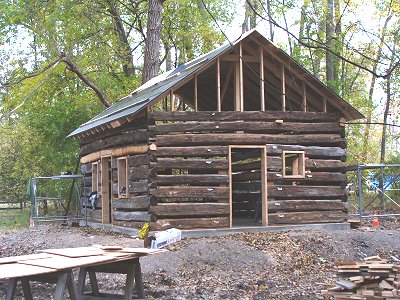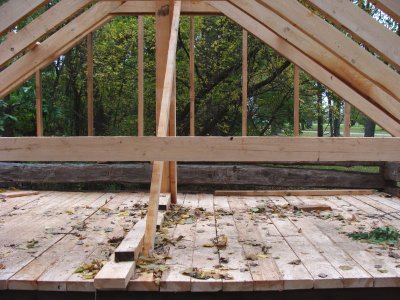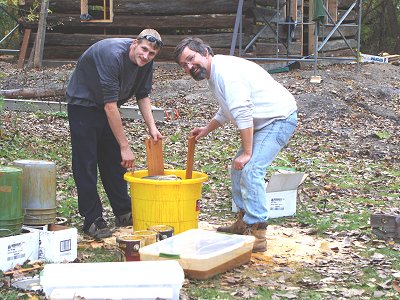- By Dan Veaner
- News
 Print
Print  This week the focus was on raising the roof of the 1791 North Log Cabin. With the walls completed almost entirely of the original hemlock logs last week, construction on the rafters began Monday. The rafters were completed Wednesday, and by the end of Thursday the roof was planked, covered with plywood, and ready for shingles to be applied next week. (Click here to view the cabin construction gallery)
This week the focus was on raising the roof of the 1791 North Log Cabin. With the walls completed almost entirely of the original hemlock logs last week, construction on the rafters began Monday. The rafters were completed Wednesday, and by the end of Thursday the roof was planked, covered with plywood, and ready for shingles to be applied next week. (Click here to view the cabin construction gallery)Nothing of the original roof still exists, nor has it for over 50 years, and possibly longer. When the cabin was erected in Auburn in 1958 Professor Walter K. Long, Director of the Cayuga Museum at that time, researched affordable yet historically viable roof materials. He settled on cedar shake shingles. When the cabin was moved home to Lansing in 2007 that roof needed replacement, so no attempt was made to save it. Lindal Homes Contractor Al Roy says the new roof will also be topped with cedar shake shingles.

The shingles arrived Wednesday as the rafters were being completed. On Thursday volunteers Ed laVigne, Wayne Eldridge, and Austin May began dipping the shingles in stain. Roy says rafters were constructed from replacement logs that were not used. The logs were milled a few weeks ago to replace original logs that were too rotted to reuse. Only three of six 24 foot replacement logs were needed, so the rest were repurposed, cut into planks to make the rafters. There were also some 18 foot replacement logs that were also repurposed.
"There will be no waste," Roy says. "Everything is being used."
The new roof will overhang the cabin by about a foot to provide added protection for the original log section, something that was not done in Auburn. The roof was planked this week, and will also have a plywood layer. Volunteers began dipping the shingles in stain Thursday before they are put onto the roof next week. Carpenter Dan Newton says they should last for a long time.

In Auburn the cabin had a loft with a stairway leading up to it. There is no evidence that the stairway was historically accurate, and for now only half the loft is being planked, so visitors can look up to see it and the roof area. Town officials anticipate that the inside of the cabin will be open by appointment once it is completed. There are no plans to do anything with the interior yet, but Lansing Community Council President Ed LaVigne says he hopes a 'Friends of the North Log Cabin' group will form to raise more money and decide what treatment the interior should have.
The cabin was originally built near the intersection of Conlon and Searles Roads by Thomas North, who had moved to the area from Pennsylvania after the Revolutionary War. Two of his grandsons migrated to Michigan in 1836 and had their new community named Lansing after their home here. It was disassembled and moved about a mile north in 1844, and disassembled again in 1958 to be reassembled in Auburn.

Austin May (left) and Ed LaVigne dipping shingles
Lansing Town Councilman Bud Shattuck was instrumental in saving the cabin when the Cayuga Museum decided they didn't want the cabin any more. After negotiating with the museum Lansing Highway Department workers took the cabin apart log by log and stored it until it could be reassembled. This year LaVigne raised most of the money needed, and ground was broken at the new site at Myers Park on September 3rd.
Next week should see the end of the project that Roy and his crew are involved with. The roof will be completed, and the ends of the roof planked. Boy Scout Martin Keefe will apply chinking between the logs once Roy and his crew have finished construction. Chinking is a concrete-like substance applied in between the logs to provide some insulation and protection from the wind. Keefe will also build a kiosk on which a sign will be placed explaining the history of the structure.
----
v5i40



